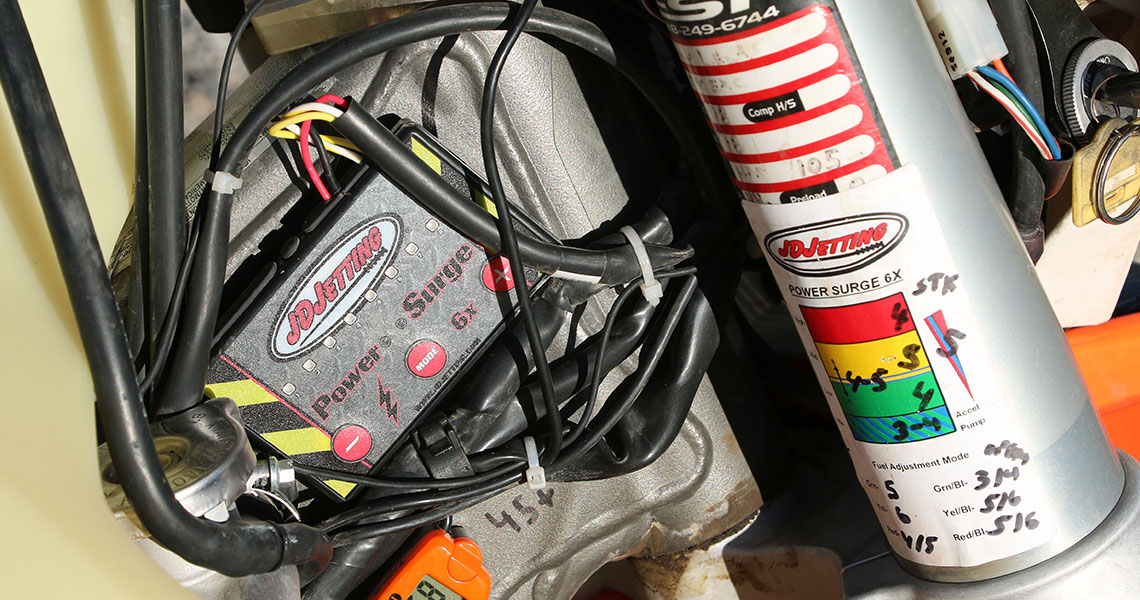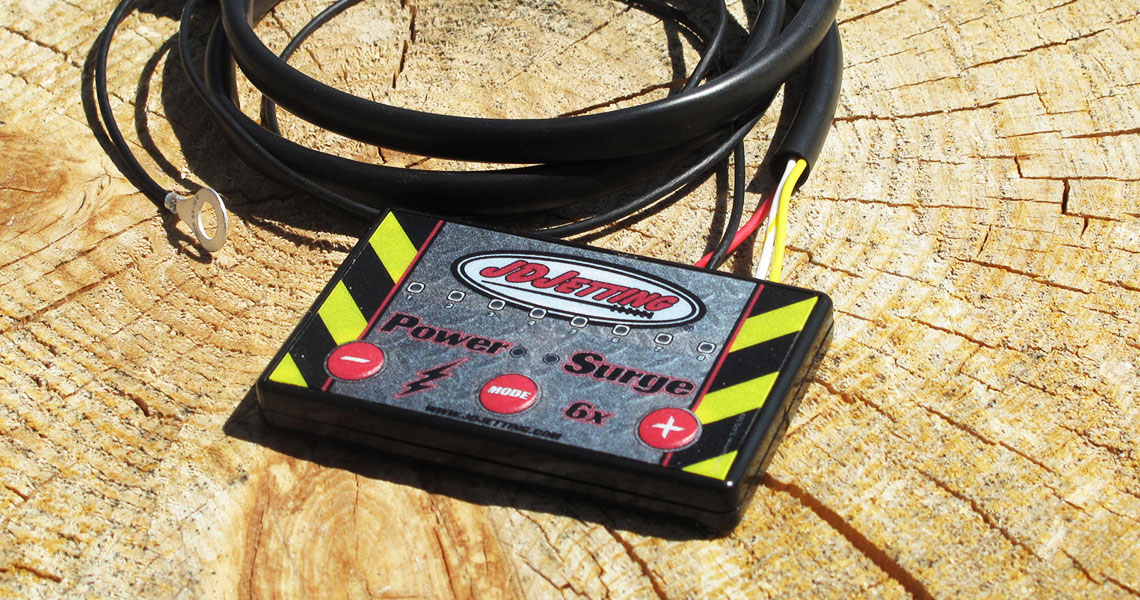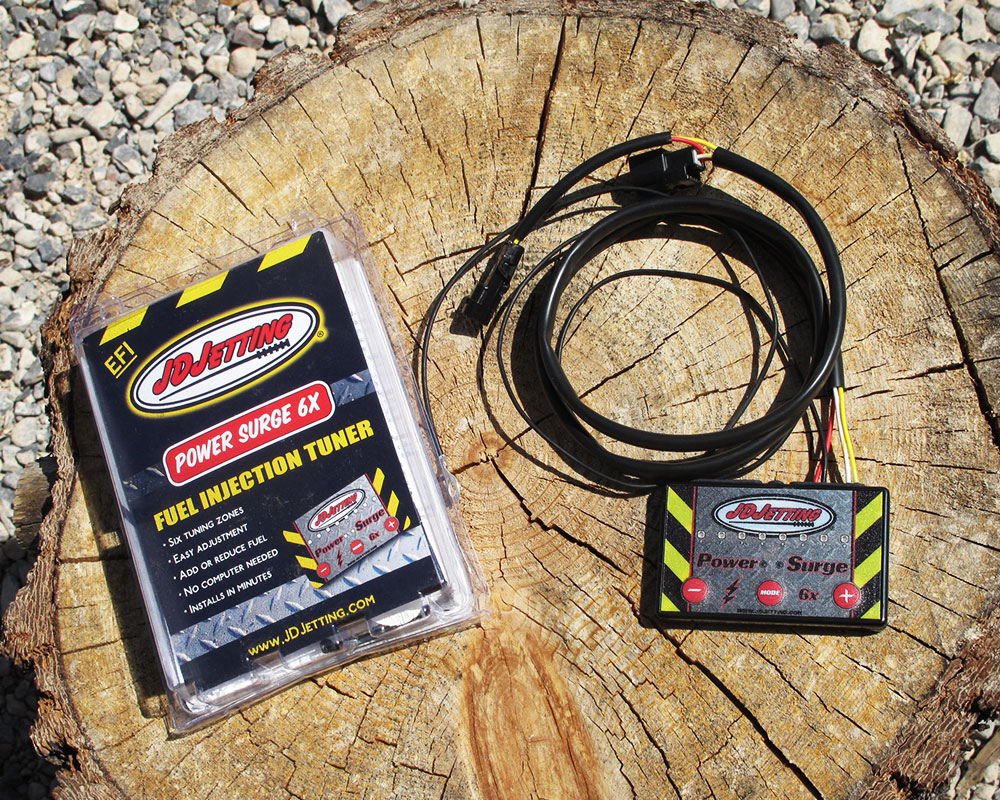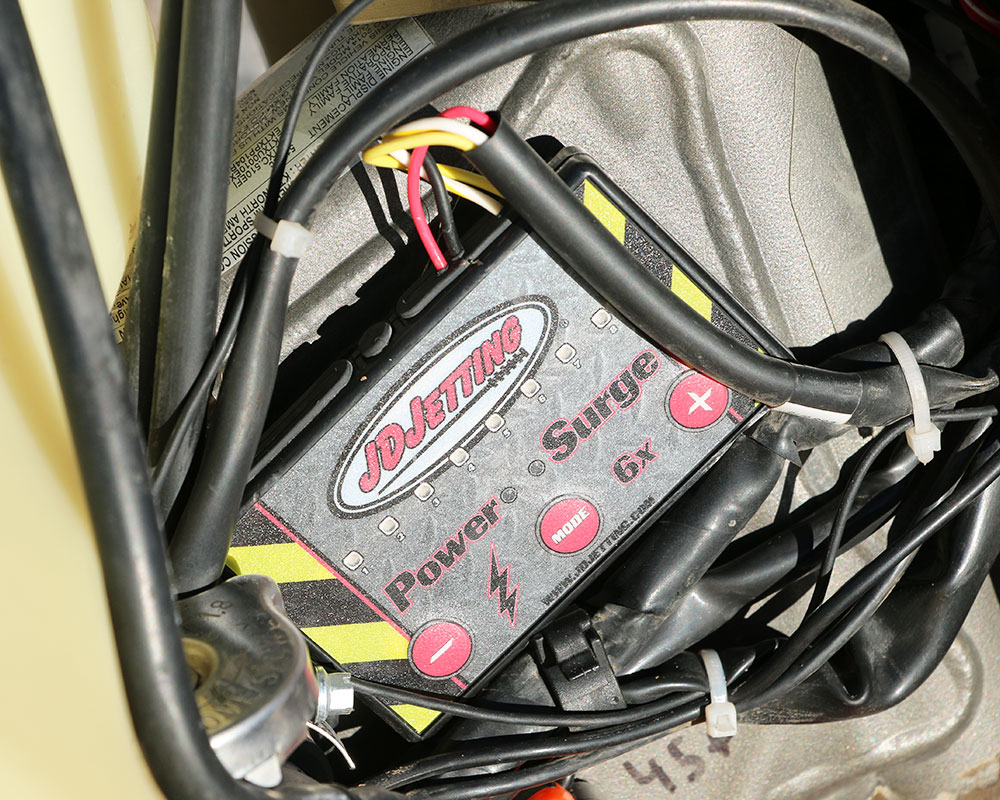JD Jetting Power Surge 6X Fuel Injection Tuner
Company: JD Jetting
Price: $224.95
- Easy install and instant improvement.
- Allows tuning of the fuel map to make your bike run exactly how you'd like.
- Backfiring and unwanted surging is eliminated.
- Careful with the wire routing.
- Memorizing the colors for each zone is tough, use the provided sticker as a reference.
What it is
JD Jetting’s Power Surge 6X is a plug-in modification that allows fuel delivery correction for humidity, temperature, air pressure, along with race fuels and motor modifications. It is plugged in-between the bike’s stock wires to the fuel injector and the injector itself and is powered by the motorcycle without any additional power requirements. It can add or subtract fuel from the injection system. Adjustable through six zones based on RPM range and including an accelerator pump feature for more or less throttle response. The unit is adjustable through a series of button pushes and corresponding colored LED lights and blinks. JD claims increase power, improved throttle response, easy adjustment, easy instillation and logic similar to tuning a carburetor. The unit comes with detailed instructions and is pre-configured to the recommended setting for your application. Additionally there are optional settings included in the information based on your bike’s setup or the conditions you ride in.
How it works
The Power Surge is pretty simple to install as far as plugging it in and finding a place for the ground wire, all detailed in the instructions. The trick is in finding it an easy-to-get-to home on the bike as things have become very congested these days. On the KTM 500EXC we tested on we were able to find a spot near the right side of the headset to attack the unit with the included Velcro and took care running the wires where they wouldn’t touch or burn on anything. It took about an hour but since little electrical issues are hard to diagnose and fix we took extra care in mounting and routing. We have seen others mount the unit under the seat and in the airbox area, even behind the headlight but we chose our location for ease of getting at it for tuning. After many hours on the bike it has never come loose and hasn’t caused any issues.
Just putting the unit on and riding there are some very significant improvements right away. Firstly on a 100% stock KTM 500EXC (right down to the perforated plug still being in the muffler) it made the bike fire up easier (no matter the temperature), idle and run smoother, pull better at lower RPMs, pull harder at upper RPMs, minimized stalling, got rid of most of the backfiring on deceleration and had the bike getting slightly better fuel mileage. Mileage went up since it was easier to ride a gear higher (yes, with stock gearing!). We did not make any adjustments but later would find out we could have made this bike run even better with some tuning.
Then we mounted the unit on another KTM 500EXC that had proper 14/50 gearing, the muffler plug removed and exhaust gas air injection removed and had a very similar result. Everything was better and zero backfiring. There were some recommended settings for the more open exhaust and we tried them with positive results. Mostly a stronger pull and better pick-up on roll-on.
The unit’s final home came on a KTM 500EXC that had an ECU that had been flashed to the European EXC setting and was running an FMF Q4 with a Megabomb header and the air-injection plugged. Here we started with the standard setting and tried a few of the recommended calibrations for both EXC and XC-W. All had positives and negatives but here is where we learned about the advantages of the easy tuning in the field. Easy only after you learn the sequence of the button pushes and if you have the sticker or instructions showing the correlation of the lights colors and blinks to what you are doing to the bike. We will not be shy about saying it takes a little time and a few runs through to get comfortable but after a while it becomes very easy and very quick. Then there is the whole issue of feeling the changes and being confident understanding what you are doing. Good thing you can always change it right back or even set it so that there is no effect from the box if you wish (a setting #3 across the range). If you are confused there are working demos online through JD jetting to give you a lesson.
In playing with the tuner we found that you could gain and lose a little power feeling in the different ranges by trimming the fuel but never really get the bike so lean or rich that it would damage anything. And we feel the biggest asset to the system is the use of the red/blue adjustment for what would be called the accelerator pump but is often called transients in FI talk. It is the adjustment that compensates for throttle opening or change in throttle position the way a pumper carb would squirt gas in a very mechanical way. This setting was the most noticeable way to make the bike feel more aggressive or mellow and worked in tandem with having changes in certain ranges amplifying or decreasing the throttle response. After all you are constantly moving the throttle.
And interestingly enough my final setting for my KTM 500 was to be leaner than standard in almost all the ranges but then being much richer in the red/blue accelerator setting. The bike felt smoother at steady throttle and got incredible mileage but when I got on the throttle it was way more responsive. It amplified the effect of the FMF Megabomb header at sharping up the throttle response but never crossed the line into being too snappy or having a true “hit” which I don’t like. But I’m sure I could have tuned hit into the package if I had so desired. The biggest bonus was the elimination of stalling, even with a Rekluse clutch set so that it drags most of the time.
After more than 40-hours on my personal bike and in riding with two other riders who have the same amount of time with the X6, if not more, we have not experienced any issues or downsides, just better running and more efficient performance and fuel economy. And even if there were an issue the tuner can be unplugged out of the bike’s system as quickly as you can access the plug atop the fuel injector.
At $225 this tuner is a great value in the modification department. It helps a stock bike, as delivered. It will allow you to get the most out of any current or further engine modification. Once set can largely be ignored. But if you like to have your bike running perfect for you and are willing to take the time to tune with the X6 there isn’t a bike this unit would not benefit.
Help support this site by purchasing through this link:
Leave a Reply









7 Responses to “JD Jetting Power Surge 6X Fuel Injection Tuner”
George Pennington
I concur with your findings, and can’t believe this product hasn’t been covered in the mainstream print mags. I put it on a ’14 Honda CRF450R that I use for Hare Scrambles racing. My main goal was to eliminate flameout stalling. I started with a heavier flywheel in an attempt to curb that, but had minimal results. After installing the tuner, I was able to tune it to not only reduce flameouts by at least 75%, but as a side benefit, starting is so much easier and now I have a lot more pep through the mid-range with a nominal gain in top-end and rev. For the price, it was a great mod, and I didn’t have to send my ignition anywhere to have it reprogrammed.
David Cheshire
Is the X6 a similar product to a power commander? I added a power commander to my 2012 TE310 Husky and it made a noticeable improvement . I now have a 2013 TE310R and whilst from stock it’s a big improvement on the 2012 I’m considering sourcing the I believe now available Power Commander for the 2013.
Jimmy Lewis
They are similar in what they do but completely different companies. I have had similar good results with both. My experience is the JD Jetting unit is much more plug and play and the DynoJet has more features if you add them.
Marc Salvisberg
If working with a dyno, the power commander has much tighter rpm and throttle position % resolution for tuning to a finer degree. The other device is more focused towards guys who are rough tuning by feel with track or trail testing. Having a limited number of “zones” is more digestible when tuning by feel.
Most tuners prefer finer resolution, though.
Rich
How does this compare with a Dyno Jet Power Commander? And while the improvement that I got when installing a power commander on my ’09 RMZ450 was immediate and impressive, the fact that it wasn’t very water proof was a major negative ~ especially on a dirt bike. So how water proof is the JD Tuner?
Jimmy Lewis
We are testing it now. It has helped a lot. Not sure about waterproof, we’ve not had an issue on other bikes.
Jimmy Lewis
The Vortex allows ignition mapping tuning. It is exponentially more complex. So it can do a lot more. But how deep do you want to go is the question? The JD is simple and very effective at addressing the needs of these bikes when switching anything that has to do with flow in the engine. All of the “re-flashing” of the stock ECUs, in my opinion, just moves the problem around and would still need additional fuel tuning to make it right.